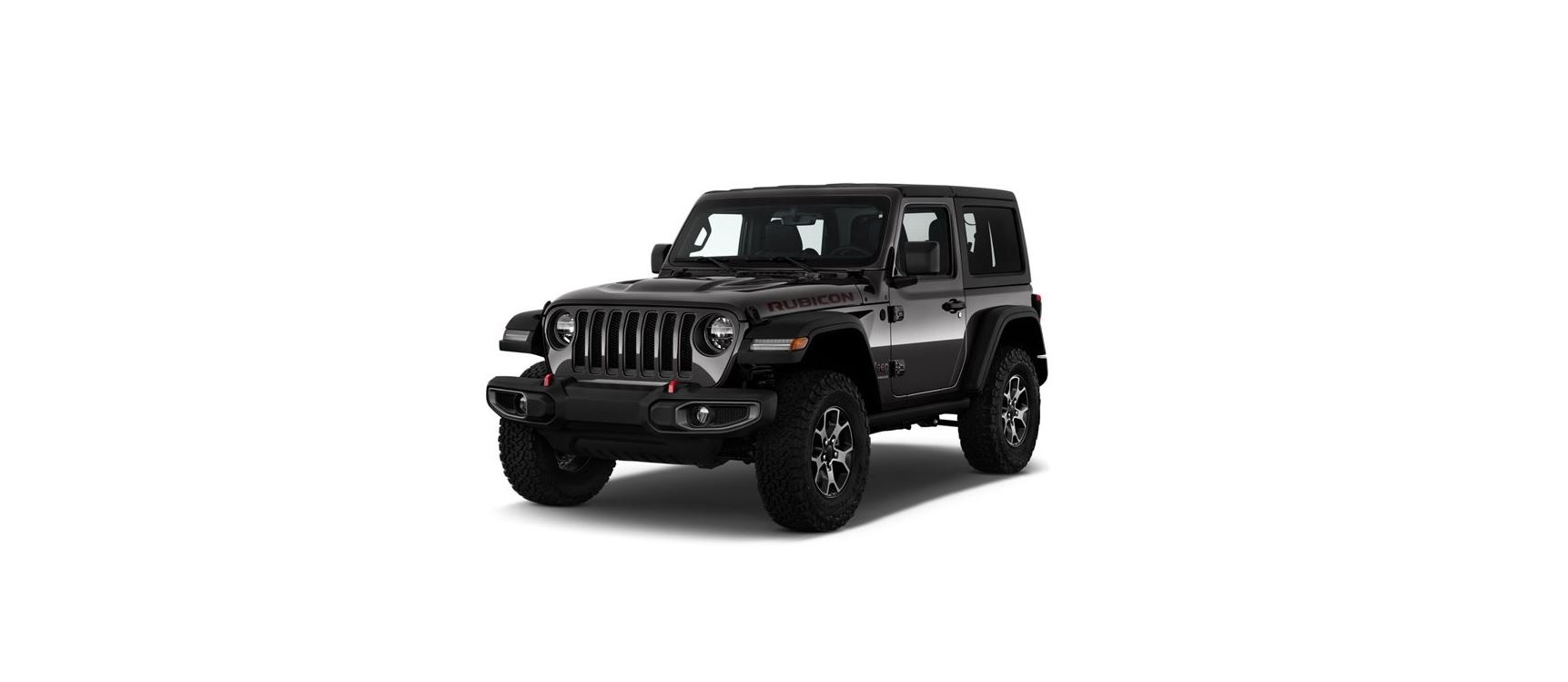2022 Jeep Wrangler Doors
DOORS
CAUTION
Careless handling and storage of the removable door panels may damage the seals, causing water to leak into the vehicle’s interior..
MANUAL DOOR LOCKS
All doors are equipped with an interior rocker-type door lock lever. To lock a door when leaving your vehicle, push the rocker lever forward to the lock position and close the door. To unlock the door, push the rocker lever rearward.
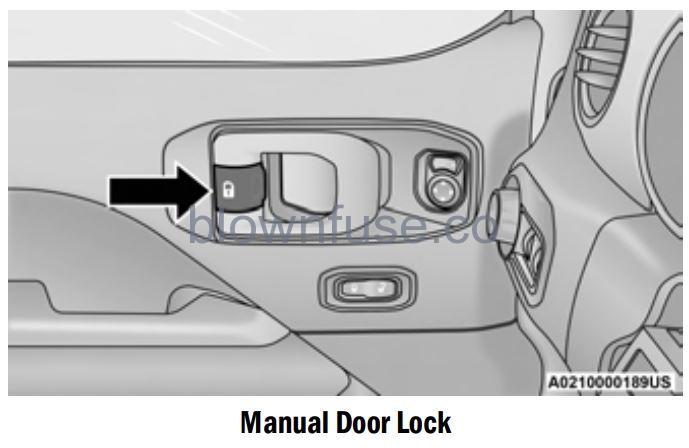
NOTE
The mechanical flip key can be used to lock or unlock the doors, swing gate (if equipped with a lock), glove compartment, and console storage.
WARNING
- For personal security reasons and safety in a collision, lock the vehicle doors when you drive, as well as when you park and exit the vehicle.
- When exiting the vehicle, always switch off the ignition and remove the key from the vehicle. Unsupervised use of vehicle equipment may cause severe personal injuries and death.
- Never leave children alone in a vehicle, or with access to an unlocked vehicle.
- Allowing children to be in a vehicle unattended is dangerous for a number of reasons. A child or others could be seriously or fatally injured. Children should be warned not to touch the parking brake, brake pedal or the gear selector.
- Do not leave the key fob in or near the vehicle or in a location accessible to children. A child could operate power windows, other controls, or move the vehicle.
POWER DOOR LOCKS — IF EQUIPPED
The power door lock switch is located on each front door panel. Push the switch forward to unlock the doors, and rearward to lock the doors.
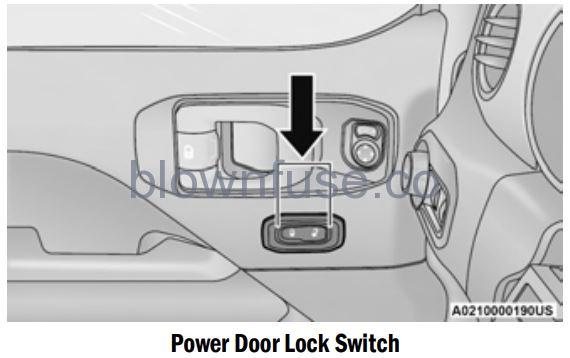
WARNING
- For personal security reasons and safety in a collision, lock the vehicle doors when you drive, as well as when you park and exit the vehicle.
- When exiting the vehicle, always switch off the ignition and remove the key from the vehicle. Unsupervised use of vehicle equipment may cause severe personal injuries and death.
WARNING
- Never leave children alone in a vehicle, or with access to an unlocked vehicle.
- Allowing children to be in a vehicle unattended is dangerous for a number of reasons. A child or others could be seriously or fatally injured. Children should be warned not to touch the parking brake, brake pedal or the gear selector.
- Do not leave the key fob in or near the vehicle or in a location accessible to children. A child could operate power windows, other controls, or move the vehicle.
KEYLESS ENTER ‘N GO™ —PASSIVE ENTRY (IF EQUIPPED)
The Passive Entry system is a feature that allows you to lock and unlock the vehicle’s door(s) and swing gate without having to push the key fob lock or unlock buttons.
NOTE
- Passive Entry may be programmed on/off within the Uconnect Settings page 207.
- The key fob may not be detected by the vehicle Passive Entry system if it is located next to a mobile phone, laptop, or another electronic device; these devices may interfere with the key fob’s wireless signal and prevent the Passive Entry system from locking/unlocking the vehicle.
- Passive Entry Unlock initiates an illuminated approach (low beams, license plate lamp, position lamps) for whichever time duration is set between 0, 30, 60, or 90 seconds. Passive Entry Unlock also initiates two flashes of the turn signal lamps.
- If wearing gloves, or if it has been raining/snowing on the Passive Entry door handle, the unlock sensitivity can be affected, resulting in a slower response time.
- If the vehicle is unlocked by Passive Entry and no door is opened within 60 seconds, the vehicle will relock and, if equipped, will arm the Vehicle Security system.
To Unlock From The Driver or Passenger Side
With a valid Passive Entry key fob within 5 ft (1.5 m) of the door handle, grab the handle to unlock the vehicle. Grabbing the driver’s door handle will unlock the driver’s door automatically. Grabbing the passenger door handle will unlock all doors and the swing gate automatically.
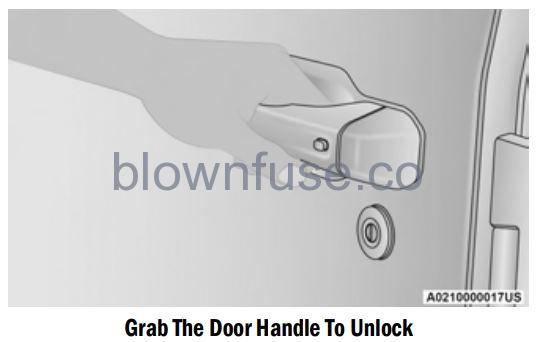
NOTE
Either the driver door only or all doors will unlock when you grab hold of the front driver’s door handle, depending on the selected setting in the Uconnect system page 207.
Frequency Operated Button Integrated Key (FOBIK-Safe)
To minimize the possibility of unintentionally locking a Passive Entry key fob inside your vehicle, the Passive Entry system is equipped with an automatic door unlock feature which will function only if the ignition switch is in the OFF position. FOBIK-Safe only executes in vehicles with a START/STOP ignition. There are three situations that trigger a FOBIK-Safe search in any Passive Entry vehicle:
- A lock request is made by a valid Passive Entry key fob while a door is open.
- A lock request is made by the Passive Entry door handle while a door is open.
- A lock request is made by the door panel switch while the door is open.
When any of these situations occur, after all open doors are shut, the FOBIK-Safe search will be executed. If it detects a Passive Entry key fob inside the vehicle, the vehicle will unlock and alert the customer. If Passive Entry is disabled using the Uconnect system, the key protection described in this section remains active/functional.
NOTE
The vehicle will only unlock the doors during a FOBIK-Safe operation when a valid Passive Entry key fob is detected inside the vehicle. The vehicle will not unlock the doors when any of the following conditions are true:
- A second valid passive entry key fob is detected outside of the vehicle (within 5 ft (1.5 m) of a Passive Entry door handle).
- The doors are manually locked using the door lock knobs.
- Three attempts are made to lock the doors using the door panel switch, and then the doors are closed.
To Lock The Vehicle’s Doors And Swing Gate
With one of the vehicle’s Passive Entry key fobs within 5 ft (1.5 m) of the driver or passenger’s front door handles, pushing the Passive Entry lock button will lock the vehicle doors and the swing gate.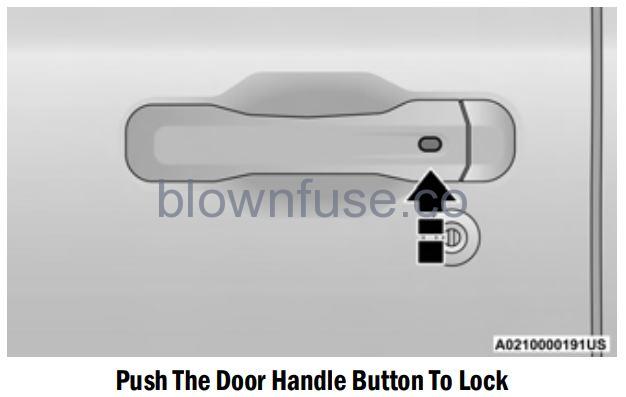
NOTE
DO NOT grab the door handle when pushing the door handle lock button. This could unlock the door(s).
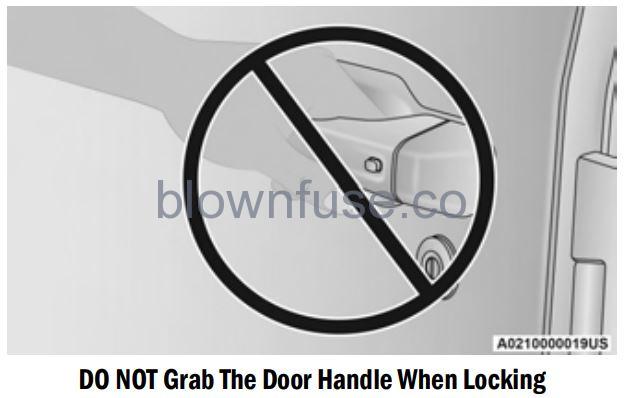
The vehicle doors can also be locked by using the lock button located on the vehicle’s interior door panel.
To Unlock/Enter The Swing Gate
The swing gate Passive Entry unlock feature is built into the swing gate handle. With a valid Passive Entry key fob within 5 ft (1.5 m) of the swing gate handle, grab the swing gate handle to unlock the swing gate automatically, and pull the swing gate to open.
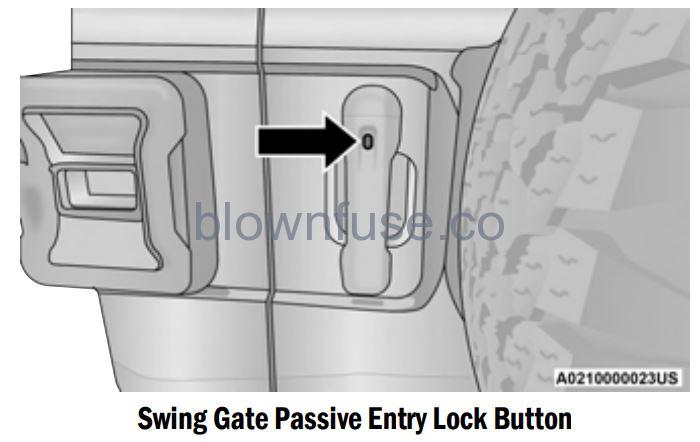
To Lock The Swing Gate
With a valid Passive Entry key fob within 5 ft (1.5 m) of the swing gate handle, pushing the Passive Entry lock button will lock the vehicle doors and the swing gate.
NOTE
- After pushing the door handle button, you must wait two seconds before you can lock or unlock the doors, using any Passive Entry door handle. This is done to allow you to check if the vehicle is locked by pulling the door handle without the vehicle unlocking.
- If Passive Entry is disabled using the Uconnect Settings, the key protection described in “Frequency Operated Button Integrated Key (FOBIK-Safe)” remains active/functional.
- The Passive Entry system will not operate if the key fob battery is depleted page 431.
AUTOMATIC DOOR LOCKS —IF EQUIPPED
The Automatic Door Lock feature default condition is enabled. When enabled, the door locks will lock automatically when the vehicle’s speed exceeds 15 mph (24 km/h). The Automatic Door Lock feature can be enabled or disabled by an authorized dealer per the written request of the customer. Please see an authorized dealer for service.
CHILD-PROTECTION DOOR LOCK SYSTEM — REAR DOORS
- To provide a safer environment for small children riding in the rear seats, the rear doors are equipped with a Child-Protection Door Lock system.
- To use the system, open each rear door, use a flat-blade screwdriver (or mechanical key) and rotate the dial to the lock or unlock position.
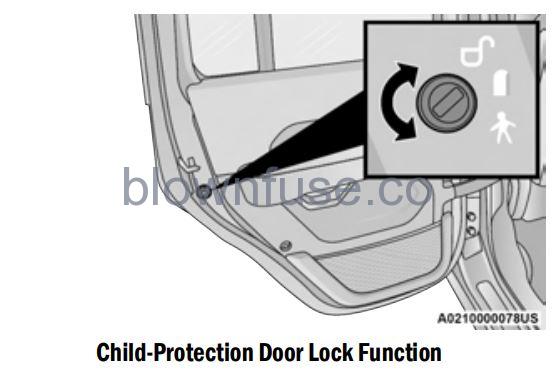
NOTE
- When the Child-Protection Door Lock System is engaged, the door can be opened only by using the outside door handle even though the inside door lock is in the unlocked position.
- After disengaging the Child-Protection Door Lock system, always test the door from the inside to make certain it is in the unlocked position.
- After engaging the Child-Protection Door Lock system, always test the door from the inside to make certain it is in the locked position.
- For emergency exit with the system engaged, move the lock lever rearward (located on the door trim panel), roll down the window and open the door with the outside door handle.
WARNING
Avoid trapping anyone in a vehicle in a collision. Remember that the rear doors can only be opened from the outside when the Child-Protection locks are engaged (locked).
NOTE
Always use this device when carrying children. After engaging the child lock on both rear doors, and check for effective engagement by trying to open a door with the internal handle. Once the Child-Protection Door Lock system is engaged, it is impossible to open the doors from inside the vehicle. Before getting out of the car, be sure to check that there is no one left inside.
FRONT DOOR REMOVAL
WARNING
Do not drive your vehicle on public roads with the doors removed as you will lose the protection they can provide. This procedure is furnished for use during off-road operation only.
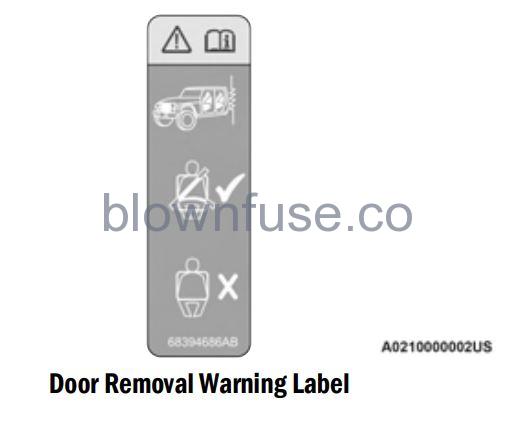
WARNING
- All occupants must wear seat belts during off-road operations with doors removed. For off-road driving tips, see page 200.
- Do not store detached doors inside of the vehicle, as they may cause personal injury in the event of an accident.
Outside rearview mirrors are mounted on the doors. If you choose to remove the doors, see an authorized dealer for a replacement cowl-mounted outside mirror. Federal law requires outside mirrors on vehicles for on-road use.
NOTE
- Doors are heavy; use caution when removing them.
- The hinge pin can break if overtightened during door reinstall (Max Torque: 7.5 ft· lb / 10 N·m). For off-road driving tips, see page 200.
- When front doors are removed, the message “Blind Spot Alert Temporarily Unavailable” will display in the instrument cluster display. Power Mirrors and Power Door Locks will also be unavailable.
To remove the front doors, proceed as follows:
- Roll down the glass window to prevent any damage.
- Remove the hinge pin screws from the upper and lower outside hinges (using a #T50 Torx head driver).
- Remove the plastic wiring access door under the instrument panel by sliding the plastic panel along with the door frame toward the seats until the tabs are detached.
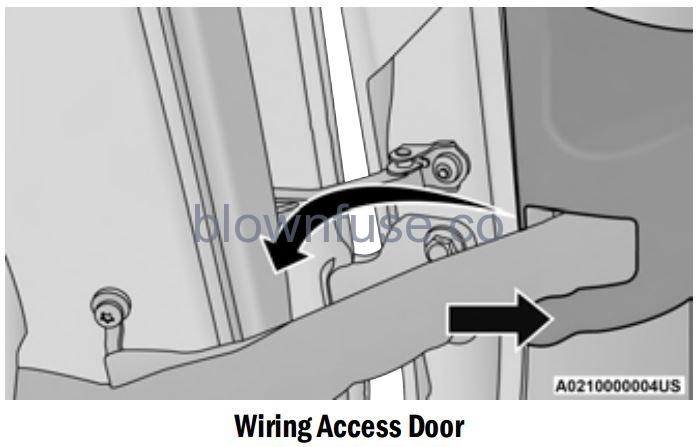
- Pull up on the red locking tab to unlock the wiring harness.
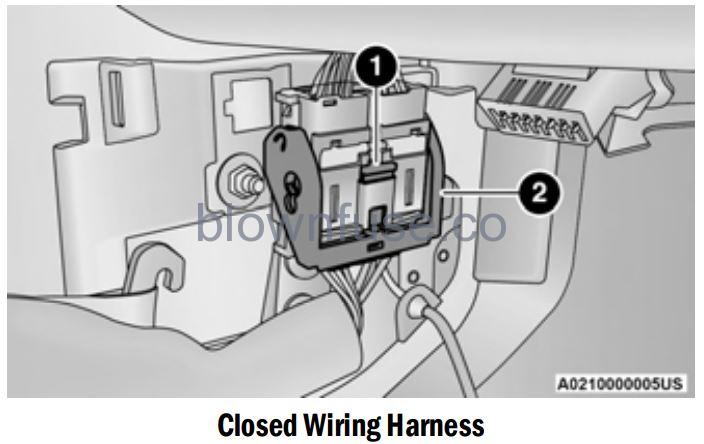
- Red Locking Tab
- Wiring Harness Lever
- Push and hold down the black security tab under the wiring harness, and lift the harness lever into the open position.
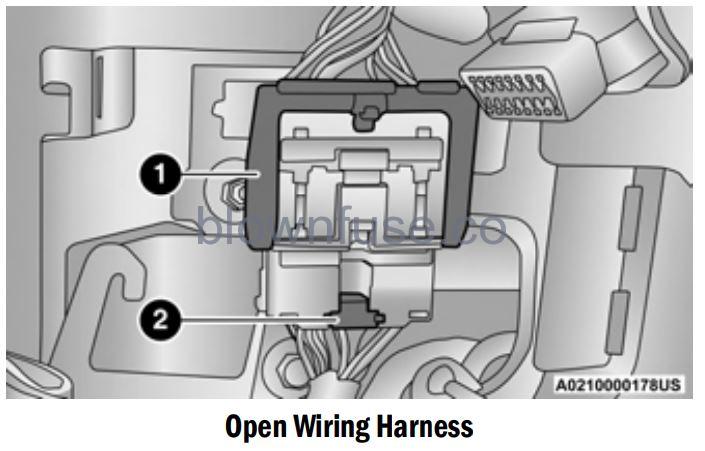
- Wiring Harness Lever (Open Position)
- Black Security Tab
- With the wiring harness open, pull straight down on the wiring connector to unplug. Store the wiring connector in the lower door basket.
- With the door in the open position, remove the check bolt from the door check attachment on the bodyside (using a #T40 Torx head driver).
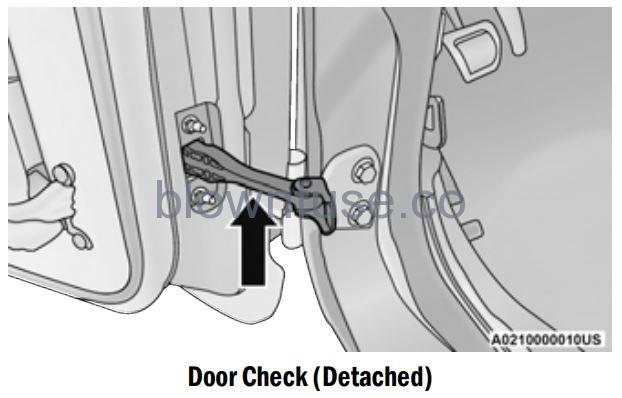
- With the door open, lift the door with the help of another person, to clear the hinge pins from their hinges and remove the door.
NOTE
The hinge pin screws and nuts can be stowed in the rear cargo tray located under the rear load floor.
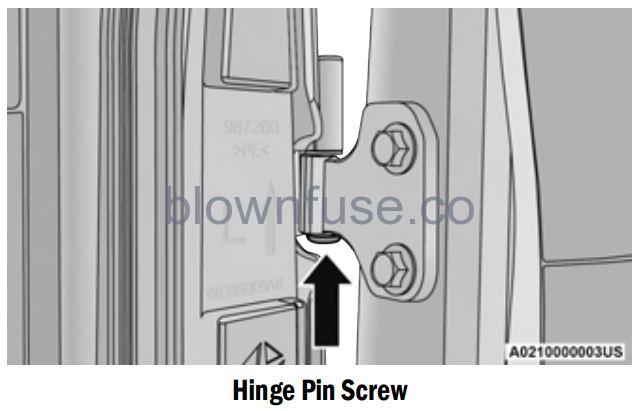
NOTE
Do not force it open; this will break the plastic cover.
To Install The Front Doors
- 1. Locate the upper and lower hinge pins on the door, and lower them into the body hinges on the vehicle
NOTE: The upper hinge pin is longer, which can be used to assist in guiding the door into place during installation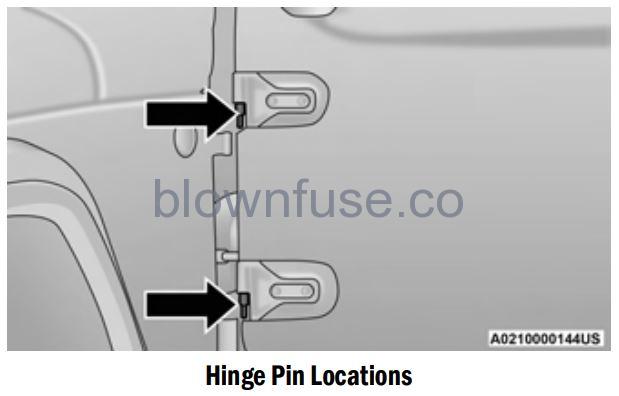
- With the door in the open position, align the door check bracket with the hole on the bodyside. Insert the check screw and tighten using a #40 Torx head driver to 19.9 ft· lb (27.0 N·m).
- Insert the upper and lower hinge pin screws into the body hinges. Tighten the screws using a #T50 Torx head driver to 3.8 ft· lb / 5.2 N·m.
CAUTION
- Do not close the door before reattaching the door check to the body. Damage may occur to the door check.
- Do not overtighten Torx fasteners, damage to the vehicle’s parts will occur.
- Hinge pins can break if overtightened during door install (Max Torque: 6.0 ft· lb/8.1 N·m).
Replacing The Wiring Connector Into The Wiring Harness
To reinstall the wiring connector on the vehicle’s door into the harness just inside the vehicle, proceed as follows:
NOTE
Make sure there is plenty of slack on the wiring connector during installation. Close the door slightly to provide more slack if needed.
- With light finger pressure, seat the wiring connector straight into the wiring harness until the wiring harness lever starts to lower with the latching pin.
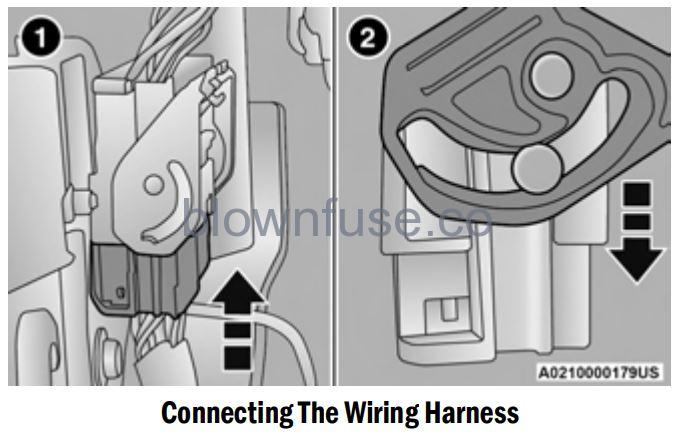
- Seat Connector Straight Into Harness
- Wiring Harness Lever Starts To Lower
CAUTION! Failure to correctly reconnect the wiring connector into the harness will result in damage that is not covered by the New Vehicle Warranty.
- After the harness lever has started to move with the pressure of seating the wiring connector, continue by lowering the wiring harness lever to the fully closed position.
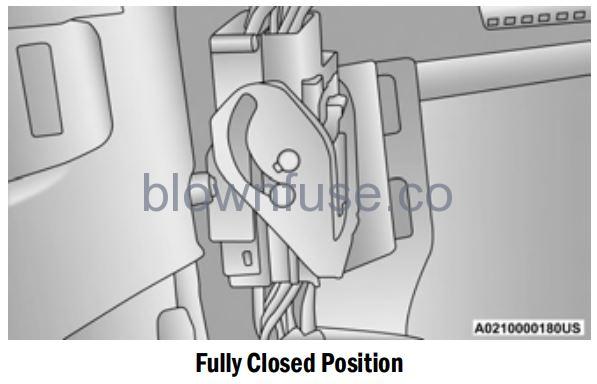
- Push the red locking tab downward to lock into place.
- Attach the cloth strap of the door onto the metal hook just inside the vehicle.
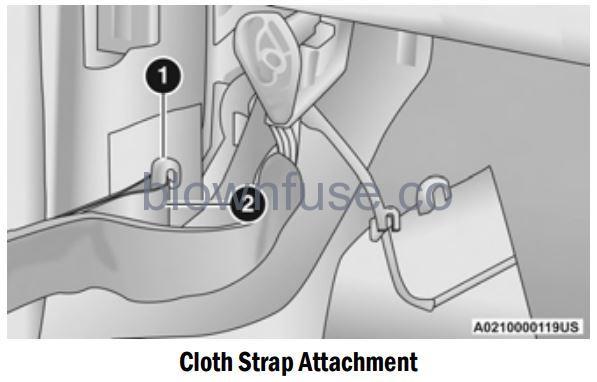
- Metal Hook
- Cloth Strap
- Replace wiring access doors.
REAR DOOR REMOVAL (FOUR-DOOR MODELS)
WARNING!
Do not drive your vehicle on public roads with the doors removed as you will lose the protection they can provide. This procedure is furnished for use during off-road operation only.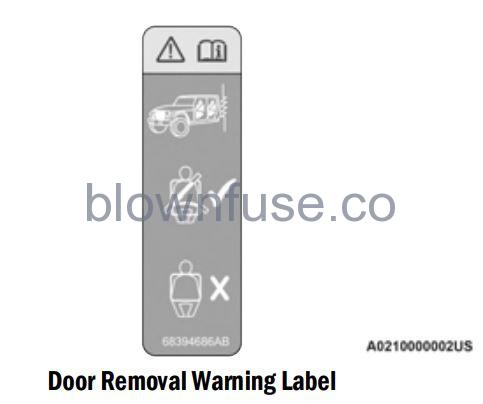
WARNING!
- All occupants must wear seat belts during off-road operations with doors removed. For off-road driving tips, see page 200.
- Do not store detached doors inside of the vehicle, as they may cause personal injury in the event of an accident.
NOTE:
- Doors are heavy; use caution when removing them.
- Hinge pin can break if overtightened during door reinstall (Max Torque: 7.5 ft· lb / 10 N·m). For off-road driving tips, see page 200.
- Roll down the glass window to prevent any damage.
- Remove the hinge pin screws from the upper and lower outside hinges (using a #T50 Torx head driver).NOTE: The hinge pin screws and nuts can be stowed in the rear cargo tray located under the rear load floor.
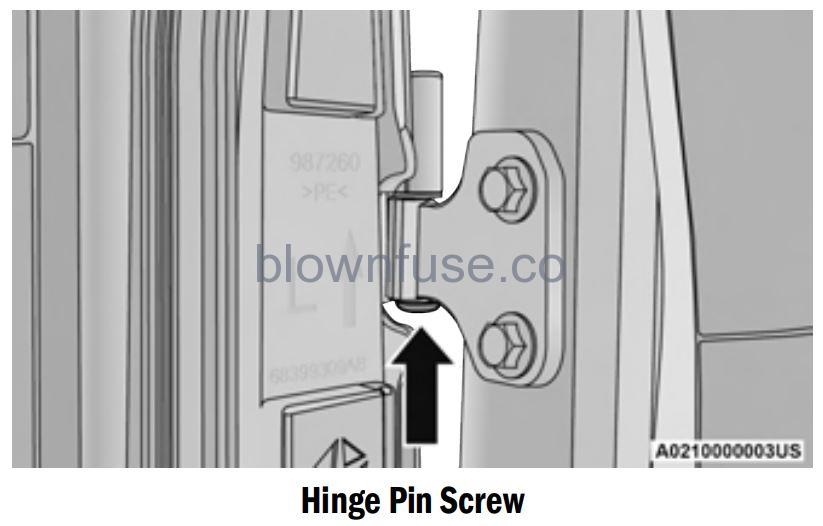
- Slide the front seat(s) fully forward.
- Pry open and remove the plastic wiring access door from the bottom of the B-pillar.
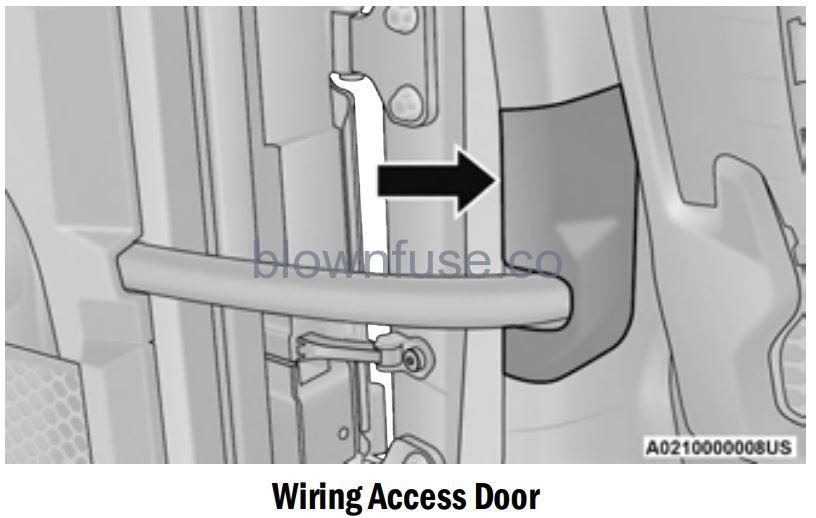
- Unplug the wiring connector.
NOTE: Squeeze the tab on the base of the wiring harness. This will unlock the connector tab, allowing the wiring connector to be unplugged.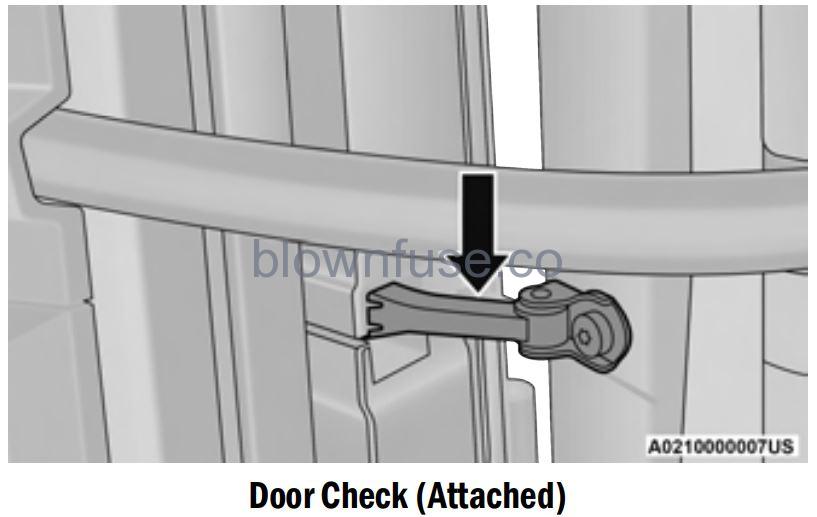
- Remove the check screw from the center door check (using a #T40 Torx head driver).

- With the door open, lift the door with the help of another person, to clear the hinge pins from their hinges and remove the door.
To reinstall the door(s), perform the previous steps in reverse order.
NOTE: The upper hinge has a longer pin, which can be used to assist in guiding the door into place when reinstalling
DOOR OFF MIRROR KIT — IF EQUIPPED
If equipped with the Door Off Mirror Kit, exterior rearview mirrors can be installed onto the upper body door hinges after the front doors have been removed.
WARNING!
- All occupants must wear seat belts during off-road operations with doors removed. For off-road driving tips, see page 200.
- Do not store detached doors inside of the vehicle, as they may cause personal injury in the event of an accident.
Use this QR code to access your digital experience
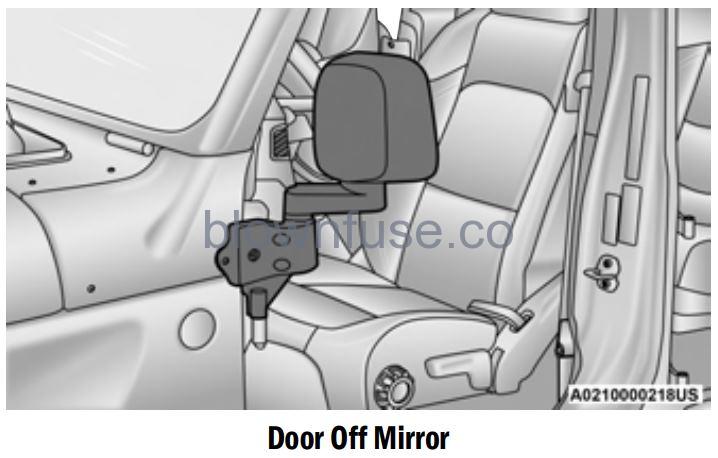
To install the Door Off Mirrors, proceed as follows
- Remove both front doors page 29.
- Remove the cowl bolt closest to the door opening using a #40 Torx head driver, and store in a safe location.
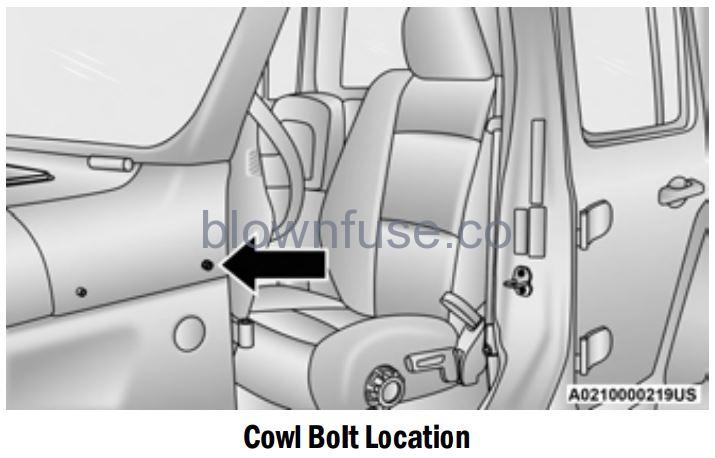
- Push the mirror bracket forward onto the A-pillar, making sure to align the bottom of the bracket with the upper door hinge, and the hole from the removed cowl bolt.
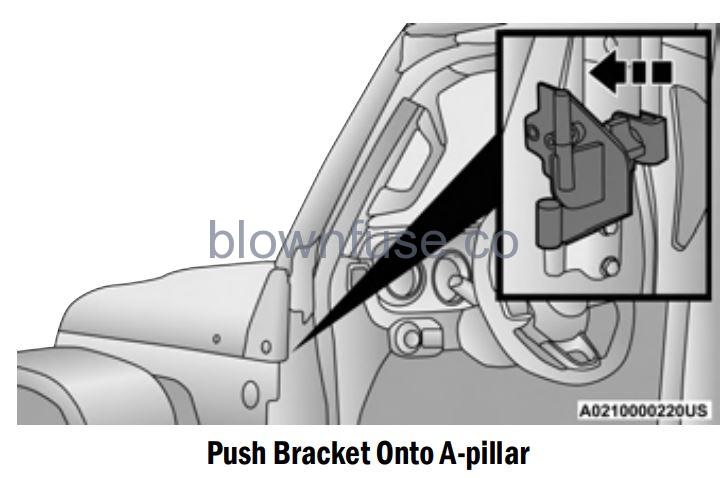
- Place the bracket bushing behind the mirror bracket (over the cowl bolt hole), then insert the bracket bolt into the mirror bracket, through the bracket bushing.
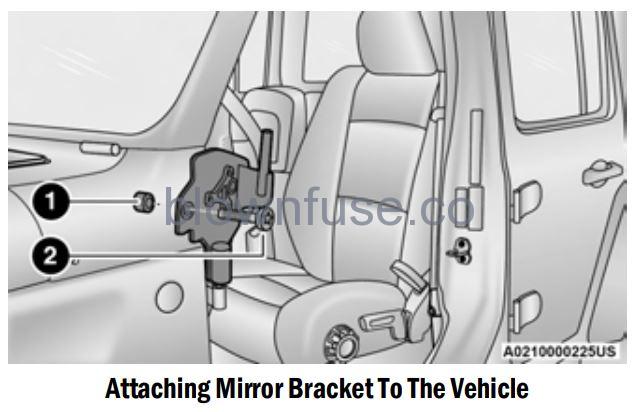
- Bracket Bushing
- Bracket Bolt
- Insert the hinge shoulder bolt through the bottom of the upper door hinge up into the mirror bracket, then rotate the bracket knob toward the rear of the vehicle to secure the mirror bracket to the A-pillar.
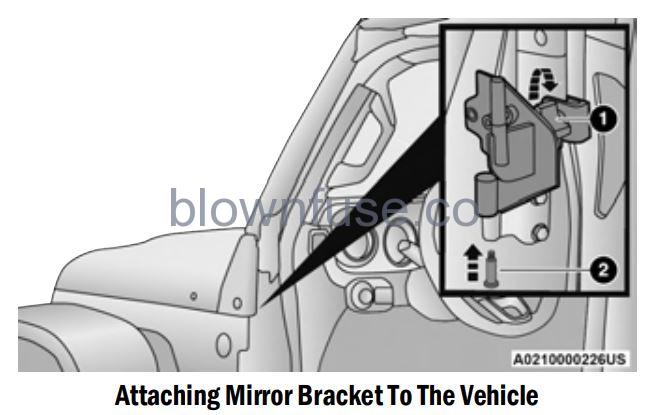
- Bracket Knob
- Hinge Shoulder Bolt
- Tighten both the bracket bolt and the hinge shoulder bolt with a #40 Torx head driver. Recommended torque specification for the bracket bolt is 6 ft-lb (8 N·m), and 7.5 ft-lb (10 N·m) for the hinge shoulder bolt.
- Lower the mirror assembly onto the mirror bracket.
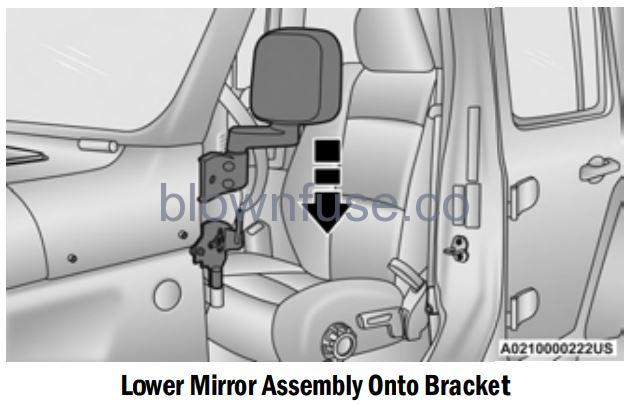
- Insert the three mirror screws into the mirror assembly, and tighten into the mirror bracket using a #30 Torx head driver. Recommended torque specification for the mirror screws is 4 ft-lb (5.5 N·m).
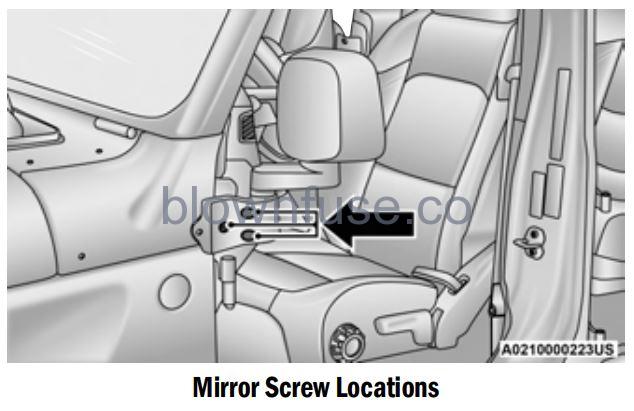
- Repeat the steps on the other side of the vehicle.
NOTE: If this kit is being installed with the optional lamp bracket, the bracket bushing from step 4 is not needed. Use the spacer from the lamp bracket.
HALF-DOOR INSTALLATION — IF EQUIPPED
If applicable, refer to the “Hybrid Supplement” for additional information.
CAUTION!
- Do not run half-doors through an automatic car wash. This may result in scratches and wax buildup on the windows.
- Careless handling and storage of the half-doors may damage the seals resulting in water leaks into the interior of the vehicle.
- The upper half-doors must be positioned properly to ensure sealing. Improper installation can cause water leaks into the interior of the vehicle.
- Store the zipper pulls of the upper half-door windows at the upper B-pillar area for both front and rear doors to avoid damage to the windows when not in use.
- Do not attempt to operate the half-door zipper in temperatures of 41°F (5°C) or below. Damage to the window may occur.
Use this QR code to access your digital experience.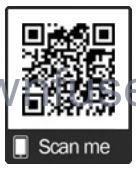
This vehicle may be equipped with half-doors. To install the half-doors in the vehicle, follow the instruction sheet packaged in the box the doors were received in. Replacement parts may be purchased through Mopar® Service.
To install the front or rear half-doors, proceed as follows:
- Remove the full doors from the vehicle. For front door removal, see page 29. For rear door removal, see page 32.
- Locate the upper and lower hinge pins on the lower half-door, and lower them into the body hinges on the vehicle.
NOTE: The upper hinge pin is longer, which can be used to assist in guiding the door into place during installation.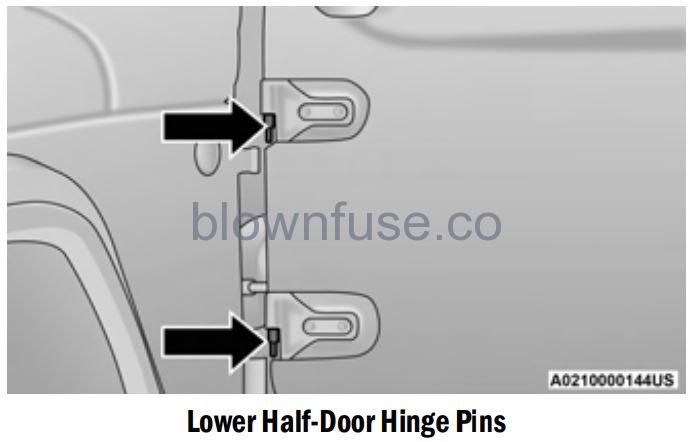
- Insert the upper and lower hinge pin screws into the body hinges. Tighten the screws using a #T50 Torx head driver to 3.8 ft· lb / 5.2 N·m.
CAUTION!- Do not close the door before reattaching the door check to the body. Damage may occur to the door check.
- Do not overtighten Torx fasteners, damage to the vehicle’s parts will occur.
- Hinge pins can break if overtightened during door install (Max Torque: 6.0 ft· lb/8.1 N·m).
- Attach the cloth strap of the lower half-door to the metal hook just inside the vehicle.
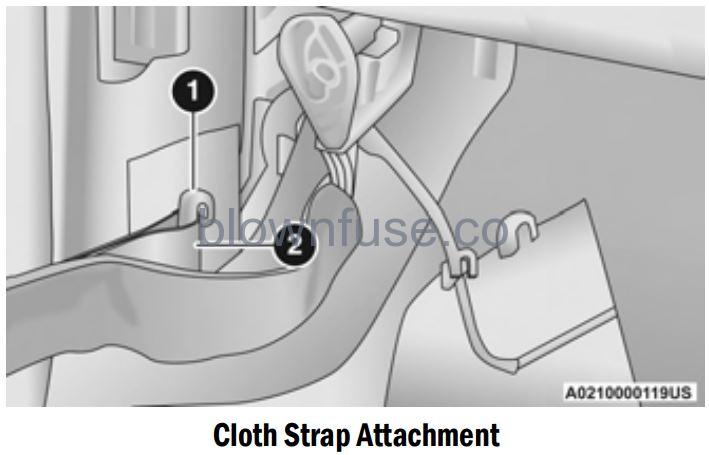
- Metal Hook
- Cloth Strap
- Connect the wiring harness on the lower half-door to the connection just inside the vehicle.
NOTE: For front doors, make sure the wiring harness is closed completely.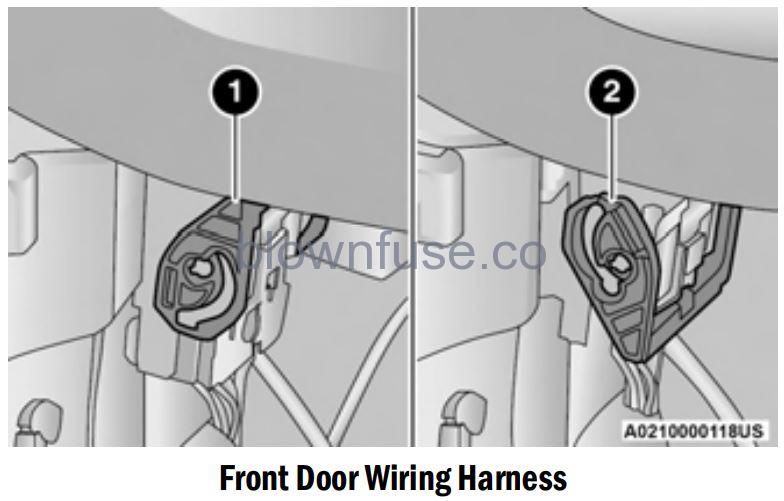
- Open Wiring Harness
- Closed Wiring Harness
- Replace wiring access doors.
- When the half-doors are shipped with the vehicle, the lower half-doors will have plugs in the post holes that must be removed prior to upper half-door installation. To remove these plugs, proceed as follows:
- Locate the service hole in the center of each plug of the lower half-door (two on each front and rear door).
- Place a tool (hook tool or trim stick is recommended) in the service hole.
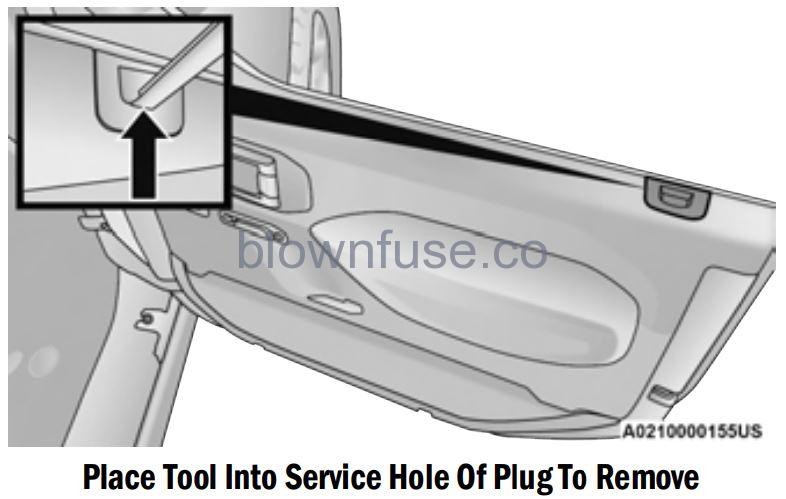
- Using the tool, slowly pull upwards from the center of the plug to remove it.
- Make sure the window on the upper half-door is completely zipped closed, insert the upper half-door into the lower half-door by placing the posts into the post holes.
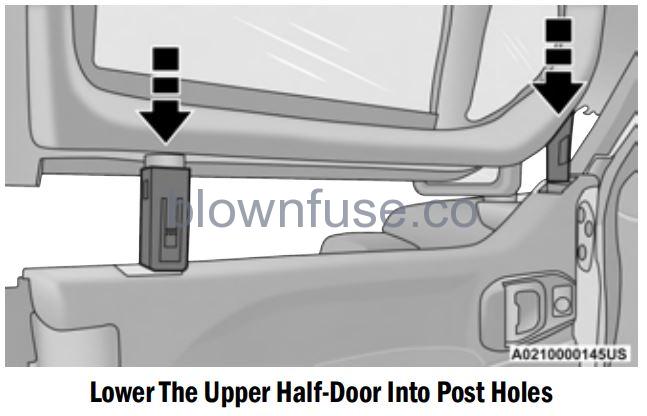
- Push down firmly on the inside of the upper half-door until it is fully seated in the lower half.
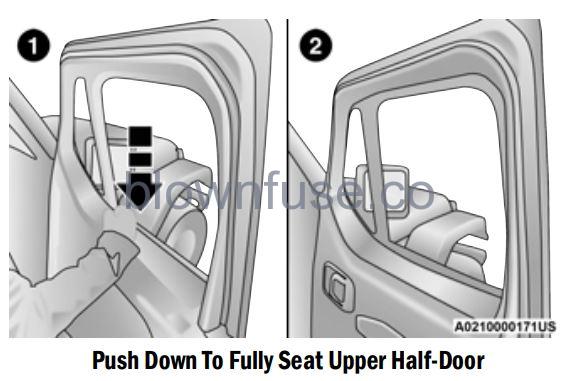
- Push Down On Inside Of Upper Half-Door
- Fully Seated Upper Half-Door
Door Latch Alignment
CAUTION! Upon the first installation of the half-doors, slowly set the door almost to the closing position and check how the door latch aligns with the body striker. Touch condition between these components can result in damage to both the door and the striker.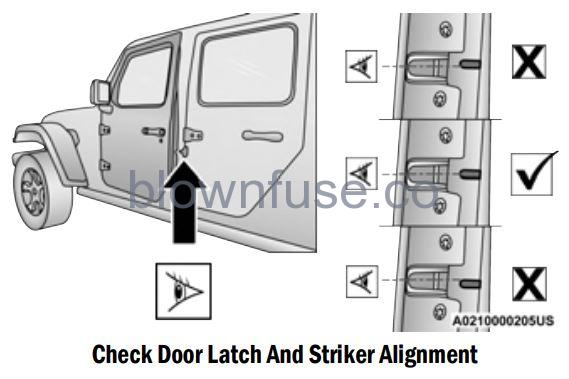
NOTE:
Only adjust the door to fit correctly against the striker. DO NOT adjust the striker, as this could affect the positioning of the full door. If the door does not center align between the latch and the striker, proceed as follows:
- Loosen (do not remove) the four bolts on the door hinges using the provided #T50 Torx head driver.
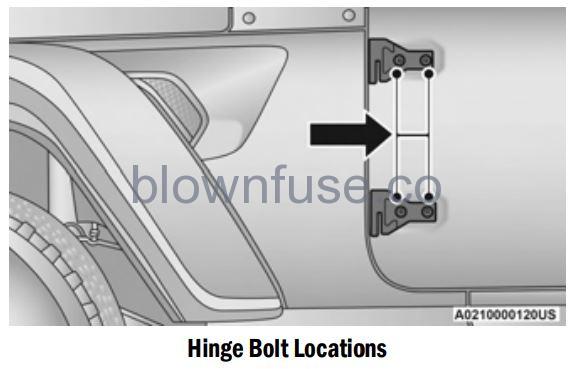
- With the bolts loose, hold the door in the almost closed position, and check that the latch and striker align.
- With the latch and striker aligned, proceed to close the door softly and tighten the hinge bolts to 20.3 ft· lb / 27.5 N·m (Max Torque: 27.3 ft· lb / 37 N·m).
Lower Door Adjustment
CAUTION
Upon first installation of the half-doors, slowly close each door to check for body contact. Improper setting of the door hinges can cause extreme non-uniform conditions, and result in damage to the body around the door.
If the door does not latch properly after installation, if there is interference between the panels, or if a non-uniform gap around the door is observed when the door is closed (example: door position appears to be low and too far rearward), the position of the door on its hinges may need to be adjusted. To do this, proceed as follows:
- Loosen (do not remove) the four bolts on the door hinges using the provided #T50 Torx head driver.
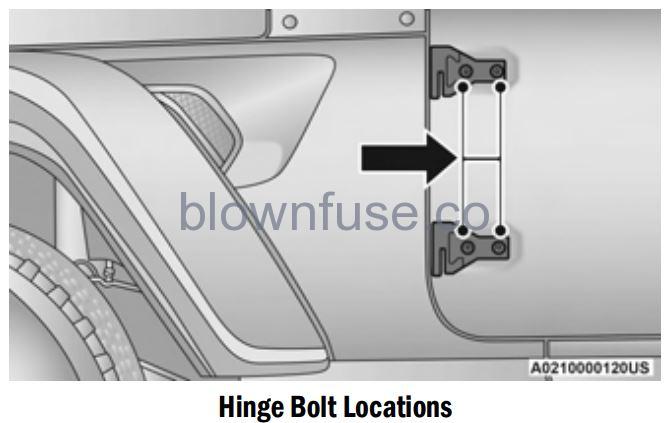
NOTE: Do not adjust the body-mounted hinges, or any part of the door latch, as modifications to these parts will affect the installation of the full door. - With the bolts loose, the door can be moved forward by pushing the door handle toward the front of the vehicle, and/or upward by grabbing the door handle and lifting towards the roof.
- Once the gaps between the door and vehicle body are uniform around the entire door, tighten the door hinge bolts to 20.3 ft· lb / 27.5 N·m (Max Torque: 27.3 ft· lb / 37 N·m).
Upper Door Adjustment
After installation of the half-doors, if water leaks or wind noise is observed, the seal of the upper half-door to the door opening may need to be adjusted.
To determine if the upper half-door needs to be adjusted, proceed as follows:
- Determine which door is affected.
- Open the affected door and hold a dollar-size piece of paper along the top of the door opening against the vehicle near where the leak/noise was observed. Make sure half of the paper is above the area where the door seal contacts the door opening, while the other half is below.
- Close the door on the paper, then pull the paper upward. If the paper moves with little to no effort, the upper half-door will need to be adjusted in that area to increase seal compression.
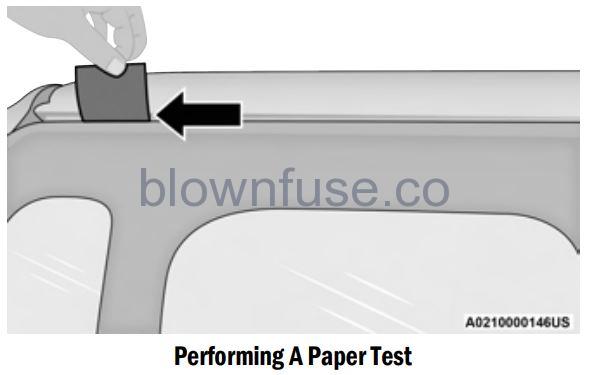
There is another optional test that can be performed using a flashlight and the help of another person.
One person should be inside the vehicle, and move the flashlight around the periphery of the door seal, shining outward. The other person should stand outside of the vehicle and check for light passing by the seal. If light is seen through the seal area, the door will need to be adjusted.
To adjust the seal compression, proceed as follows:
- Open the door and lift the upper half door up and away from the lower half. Lay the upper half-door on a clean, dry surface.
- Using an 8 mm open-end wrench (not provided), loosen the nut located inside the bottom of the upper half-door post, closest to where the “paper test” detected a gap.
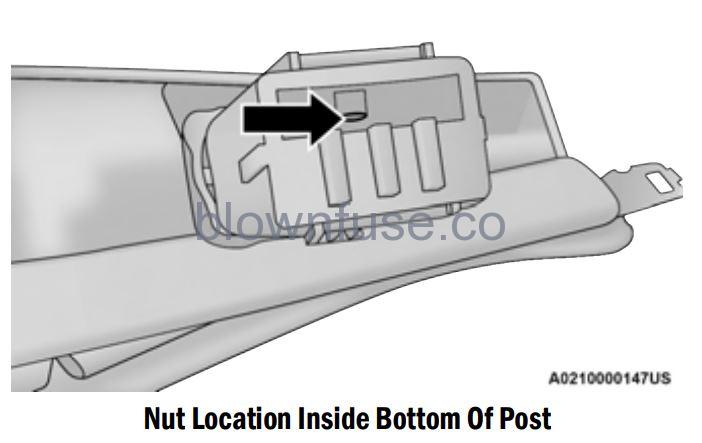
- Using a 3 mm Allen wrench (not provided), rotate the screw on the side of the post counterclockwise (while holding the wrench on the loosened bolt) to increase the seal compression. If needed, rotate clockwise to reduce seal compression.
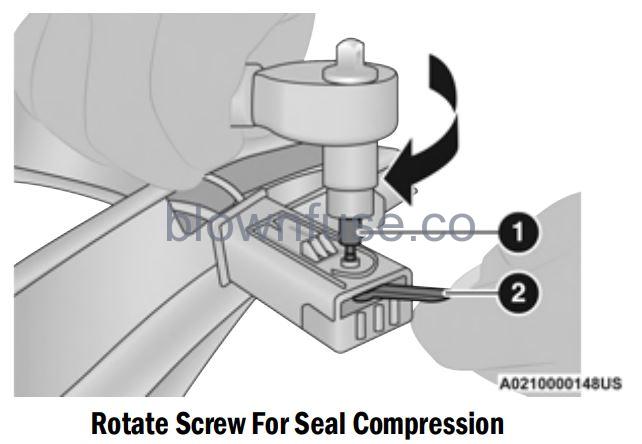
- 3 mm Allen Wrench
- 8 mm Open-End Wrench
- Tighten the nut inside the bottom of the post using the wrench and make sure the screw head is flush to the post. Reinstall the upper half-door.
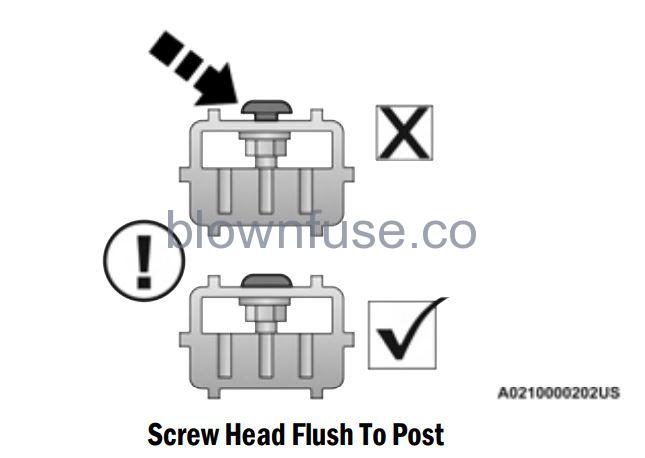
- Close the door and repeat the “paper test”. Repeat the adjustment procedure if needed.
- If needed, add the provided shim to a lower half-door pocket to seal the upper half-door to the roof:
- Lift upper half door up and away from the lower half.
- Clean the bottom of the door pocket.
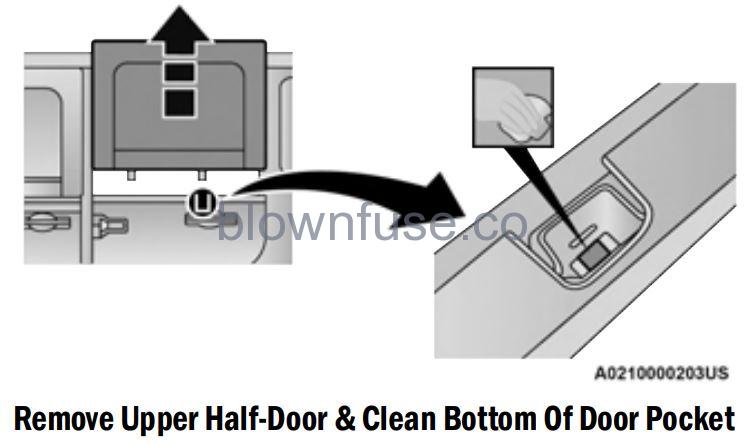
- Slide the shim onto a pencil or similar tool.
- Remove the paper backing from the adhesive side of the shim and place the shim with a pencil into the pocket.
- Press the shim firmly to the bottom of the pocket, and remove the pencil once the shim is firmly in place.
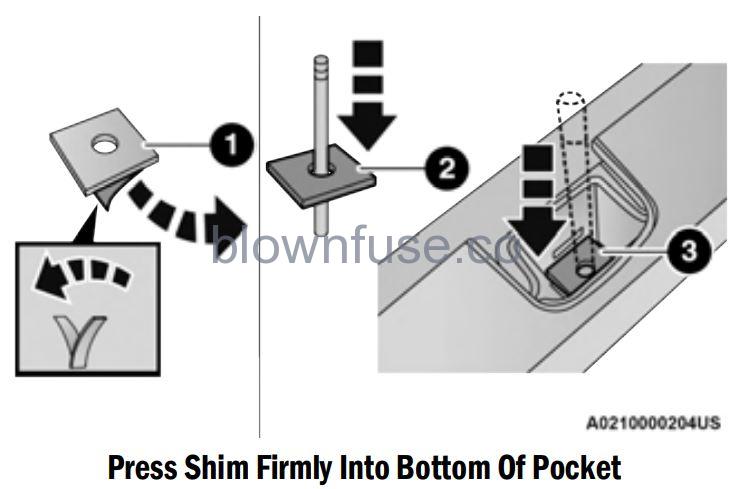
- Remove Paper Backing From Shim
- Slide Pencil through Hole In Shim
- Press Pencil With Shim Into Pocket
- Replace upper half-door.
NOTE
If the compression is increased too much on the front upper corner of the rear doors, deformation of the seal will occur.
Half-Door Removal
To remove the half-doors, repeat the installation steps in reverse order.
NOTE:
When removing the upper half-doors, push upward firmly on the middle of the upper half-door until the posts detach from the lower half.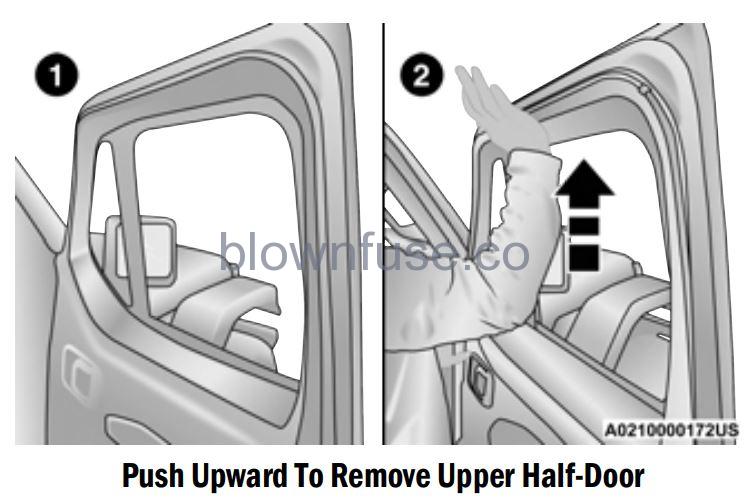
- Fully Seated Upper Half-Door
- Push Upward On Middle Of Upper Half-Door
